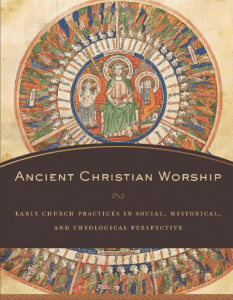 For those for whom it “does” the least, baptism is emphasized the most; for those for whom it “does” the most, it is emphasizes the least. That’s an overstatement: baptists don’t think baptism “does” much (it’s a symbol, not a sacrament; it’s real essence is faith that precedes the water) while infant baptizers think baptism “does” much but often don’t emphasize it enough. My own reading of pastors and theologians today however reveals that baptists are tending toward making more of baptism while infant baptizers are also striving to show it matters more. The second group now talks more and more about “living out or into our baptism.”
For those for whom it “does” the least, baptism is emphasized the most; for those for whom it “does” the most, it is emphasizes the least. That’s an overstatement: baptists don’t think baptism “does” much (it’s a symbol, not a sacrament; it’s real essence is faith that precedes the water) while infant baptizers think baptism “does” much but often don’t emphasize it enough. My own reading of pastors and theologians today however reveals that baptists are tending toward making more of baptism while infant baptizers are also striving to show it matters more. The second group now talks more and more about “living out or into our baptism.”
Baptism has divided the church, at times tragically (Anabaptists were murdered for renouncing their infant baptism and for undergoing a second baptism [hence, anabaptism]). Those days are behind us but baptism itself is not behind us.
Baptism, according to Andrew McGowan in his fine book Ancient Christian Worship, focuses on baptism in his chapter on initiation. Baptism is thus understood as a central practice in earliest Christian worship (which does not mean Sunday gatherings, but includes them). Every pastor needs to work though this book in order to ask if his or her church has these practices in its core identity.
So, where did baptism come from? What is the origin of baptism? McGowan gets this one right when many are getting it distorted: Christian baptism does not derive from proselyte baptism, for which there is no pre-Christian evidence; it comes from the Jewish rituals of washing. I like how he says it: “Washing practices in early Christianity and in ancient Judaism straddled the boundary between prosaic or functional washing and rituals of cleansing and renewal” (135). That is, baptism emerges from lustrations. Hence, the mikveh practice of washing sets the tone for John’s baptism and therefore Jesus’ baptism. What McGowan could have explored is John’s baptism in the Jordan, the prototypical place of covenant renewal and new beginnings. He could also have explored more than water rituals but also initiation rituals, and that means circumcision.
Baptism changes, acc to McGowan, when it moves from John and Jesus to the early Christian practice of baptism into Christ. McGowan:
The earliest Christian use of baptism was not, however, the creation of an initiation ritual for a religious group separate from Judaism, but was, like John’s baptism, a sign of participation in God’s renewal of Israel and the world. It was a means of repentance and forgiveness, of preparation for divine service, but now also of realizing belief in Jesus and of participating in the life of the Spirit—but initially still within the community of Israel (141).
From at least Paul on baptism was entrance into Christ and especially for all: Jews and Gentiles, males and females. The former element — baptism into Christ — magnifies the death and resurrection of Christ (Rom 6:3-4; cf. Col 2–3). But baptism also entailed a theology of new birth (John 3:3-6), the gift of the Holy Spirit (Matt 28:19; Act 8:16; 10:44-48; 19:1-7).
On the practice, McGowan thinks baptism was from the beginning immersion. Perhaps three times (Didache 7:1); perhaps “in the name of the Lord Jesus” (1 Cor 6:11; Acts 2:38); perhaps only at the hand of a leader (1 Cor 1:13-17); clearly entire households were baptized (e.g., Acts 11:14; 16:15, 34), so he thinks this would perhaps include infants and children. But he concedes this historical conclusion:
Yet the baptism of children and infants remains an uncertainty for the first and much of the second century; there is simply no evidence on which to base a definitive judgment. Adults were for many years to remain the normal, if not necessarily sole, recipients of baptism (145).
Baptism changed even more in the first few centuries of the church. One theme in early Christian baptism was a period of preparation — catechism and fasting.
Justin Martyr’s emphasis is that baptism entails (1) confession of the faith and (2) commitment to live in the way of the Christians. Over time the baptizer was to be the bishop and a more rigorous preparation of catechism and moral commitment was expected. There is evidence in Tertullian and esp Cyprian that the sign of the cross was applied to the one being baptized, in time done with oil. A similar development of meaning takes place with laying on of hands and the permission of the baptized to participate in Eucharist.
















